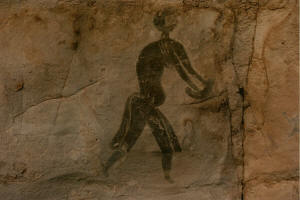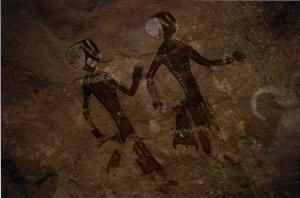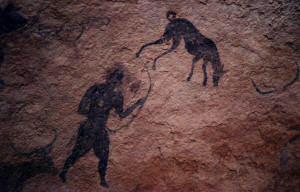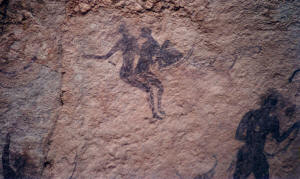Lions Pride, Chauvet Cave, excavated by Jean Clottes
This webpage is a personal follow up to my exhibition entitled Art and Human Consciousness at Fairfield University Quick Center during the fall of 2009. My aim is that it become a resource for continuing research in the fields of philosophy, art (especially drawing), anthropology and neurology. Kindly note that no one, no institution or individual, is responsible for the content of this website besides myself. Any opinions expressed are strictly my own.
Art has played a vital role in human evolution and the development of human consciousness for over 500K years…and probably much longer. The human brain case didn’t expand until the thumb dropped down to oppose the fingers. Bone record shows man has evolved but highly questionable that art has. History of art is more like a US eastern forest succession than a farmer’s field: a great fire burns the forest to the ground, grasses eventually grow, followed by small bushes, then cedars and eventually deciduous trees…oaks, maples, hickories, elms. The canopy of the deciduous trees kills the grasses. Eventually white pine and hemlock take root, grow, tower and overcome the deciduous trees…until the next fire. A fire has been raging on earth since the death of Cezanne, the last great evergreen.
Art is at the heart of the creation of science…about vision, feeling and expression. When scientific or mathematic discourse reaches the poetic...vision, expression....it caresses “being.” Like art, science and mathematics too are expressions of man’s experience of “being,”…the unmentionable in ancient Hebrew theology.
Art is philosophy by other means.
World-class speakers across the fields of anthropology, neurology, sociology and art history made formal presentations during the exhibition including: Dr. Jean Clottes (French anthropologist), Dr. Frank Wilson (American neurologist), and Dr. John Spike (Florence-based Renaissance art historian).
Besides investigating the prehistoric, biological, psychological and sociological evidence in art making and human consciousness, the speakers explored such questions as:
· Is contemporary society in danger of losing touch with humanity’s original aesthetic grounding and inspiration, namely life and even the memory of life?
· What makes drawing so distinctive and urgent?
· What are the philosophical implications of “drawing from life?”
· Does this have significant meaning and consequences outside the art community?
Also making important contributions were Stanley Bleifeld (American sculptor), Ellen Dissanayake (musicologist, sociologist, anthropologist), Dr. Diana Mille (art historian and curator of the exhibition), Dr. Philip Eliasoph (art historian and critic) and Claude January, the artist's wife and a physical organic chemist who grew up in France and knowledgeable about Algerian and French rock art first hand.
Following are some key links:
· Dr. Jean Clottes, French prehistoric art anthropologist and author who excavated Chauvet and Cosquer Caves amongst many others worldwide:
www.bradshawfoundation.com/chauvet/jean-clottes.php
· Dr. Frank Wilson, American neurologist, Pulitzer nominated for “The Hand…and Its Role in Human Evolution.” (also classical piano player), worked with gifted children many years in California
http://www.randomhouse.com/catalog/display.pperl/9780679740476.html
· Dr. John Spike, Renaissance art scholar (American living in Florence, Italy)
www.wikipedia.org/wiki/John_Spike
· Stanley Bleifeld, great American sculptor living in Piatrasanta, Italy, working in Michelangelo’s quarry
· Ellen Dissanayake, brilliant anthropologist and author of many books about the origin of art and its sociological and evolutionary impact, musicologist, piano player):
· Dan Budnik, spiritual photographer (Life Magazine, New York Times, etc): lifelong interest in prehistoric art, photographed the show and Jean Clottes' talks.
· The Bow and Lyre by Nobel Prize winner Mexican poet Octavio Paz addresses many of these questions
· Critical article from Robert January exhibition catalogue for Art and Human Consciousness, by Dr. Philip Eliasoph
www.tfaoi.com/aa/9aa/9aa241.htm
· Dan Gheno, artist, teacher...one of the best living art teachers, especially for drawing, wonderful explanation at his website:
Photos from Tassili N'Ajjer, Algerian Sahara




